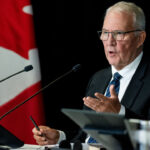Commentary
Following the latest report on consumer prices, it was not surprising to see them come in higher than expected. This was expected due to the increase in money stock and rising velocity. Real-time prices are on the rise again, despite the recent rate cuts by the Fed, which essentially amounts to quantitative easing.
The lingering effects of excessive money printing over the past four years are evident in price increases that are about 50 percent higher than the Fed’s target.
When analyzing these data releases, it’s interesting to note the patterns of energy prices decreasing, while food and transportation costs are rising, ultimately impacting the standard of living in the U.S.
Despite the clear signs of inflation, major media outlets continue to downplay the situation by using terms like “cooling” to describe the rising prices. The headlines often mask the reality of the situation by using vague language.
The reality is that inflation is not cooling as claimed, and the anti-inflation efforts of the past three years have not been effective.
Producer prices, which typically forecast future consumer prices, are showing signs of re-acceleration, indicating further inflationary pressures.
If this level of inflation had occurred five years ago, it would have caused widespread alarm. However, due to the normalization of high inflation rates, the media continues to misrepresent the situation as “cooling.”
It’s crucial for accurate and descriptive language to be used in reporting on inflation rather than relying on misleading terms.
A detailed study by Brownstone reveals that actual prices have increased by around 40 percent over four years, contradicting the lower figures reported by official sources.
The reluctance of economists to challenge the prevailing narratives on inflation highlights the need for more independent and objective analysis in the field.
Mainstream economists’ aversion to deflation and preference for inflation highlight a disconnect with public preferences for lower prices, especially after years of rising costs.
Overall, the misrepresentation of inflation and the reluctance to acknowledge its true impact underscore the need for more honest and accurate economic analysis.
The cost of software and computer memory has dropped by 90 percent over the past few decades, despite the industry’s growth. In the late 19th century, there was a general deflation in all goods and services under a gold standard regime, which coincided with unprecedented economic growth.
It is crucial for prices to stabilize now and in the future to help regain lost prosperity. Unfortunately, current trends suggest a rise in inflation, with money stock levels at an 18-month high and the Federal Reserve cutting rates in response to demands for looser credit. This could lead to higher prices and potentially a repeat of the inflation experienced in the 1970s.
The next administration will face a serious challenge in tackling inflation, which cannot be solved through anti-gouging laws or increased drilling. The root cause of the issue lies in the excessive printing of money, which may require disruptive measures like unplugging the money printer and potentially causing a deeper recession.
It is essential for the economy to adjust, face reality, and reduce its reliance on constant injections of money and credit to avoid further price increases.
Please note that the opinions expressed in this article are those of the author and do not necessarily reflect the views of The Epoch Times.
Source link





